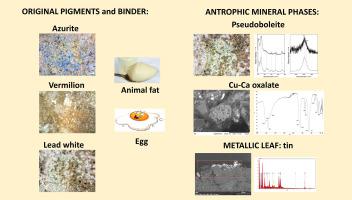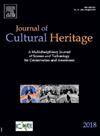Pseudoboleite as an alteration product of azurite in the painted stone of the mullioned windows of the Bargello Palace (Florence)
IF 3.3
2区 综合性期刊
0 ARCHAEOLOGY
引用次数: 0
Abstract
During the recent restoration of the Bargello courtyard and façades (13th-14th century), initiated in 2020, traces of painted polychrome decoration were identified on Pietraforte intrados and extrados of the mullioned windows. On the stone intrados, blackish lozenge-shaped impressions –likely remnants of a metallic leaf– were against a pale blue background. To investigate the original materials and painting technique, a combination of non-invasive in situ methods (digital microscopy, energy-dispersive X-ray fluorescence spectroscopy, and reflectance spectrometry) and micro-invasive analyses (optical microscope, micro-Raman, SEM-EDS, XRD, FT-IR, GC–MS, PY-GC–MS) was applied. The integrated analyses of the blue decorations revealed the presence of azurite, pseudoboleite and rare particles of lead white, along with Cu-oxalates and Ca-oxalates. The occurrence of pseudoboleite, a rare greenish mineral, suggests it formed as a result of alteration processes involving azurite and lead white, potentially triggered by chlorine-based cleaning treatments. Rare Hg-S-based particles, likely associated with vermilion, were identified in the extrados. Additionally, trace amounts of egg and a non-drying fat were detected.

巴格罗宫(佛罗伦萨)竖棂窗彩绘石中蓝铜矿的改造产物
在最近于2020年开始的巴尔杰罗庭院和faradades(13 -14世纪)修复期间,在Pietraforte intrados和extrados的棂窗上发现了彩色装饰的痕迹。在石头上,黑色的菱形印痕——可能是金属叶子的残余物——映衬着淡蓝色的背景。为了研究原始材料和绘画技术,采用非侵入式原位方法(数字显微镜、能量色散x射线荧光光谱和反射光谱)和微创分析(光学显微镜、微拉曼、SEM-EDS、XRD、FT-IR、GC-MS、PY-GC-MS)相结合的方法。对这些蓝色装饰物的综合分析显示,其中存在蓝铜矿、假闪铜矿和罕见的白铅颗粒,以及草酸铜和草酸钙。假闪辉石是一种罕见的绿色矿物,它的出现表明它是蓝铜矿和白铅的蚀变过程的结果,可能是由氯基清洁处理引发的。稀有的汞基颗粒,很可能与朱砂有关,在外皮中被发现。此外,还检测到微量的鸡蛋和一种不干燥的脂肪。
本文章由计算机程序翻译,如有差异,请以英文原文为准。
求助全文
约1分钟内获得全文
求助全文
来源期刊

Journal of Cultural Heritage
综合性期刊-材料科学:综合
CiteScore
6.80
自引率
9.70%
发文量
166
审稿时长
52 days
期刊介绍:
The Journal of Cultural Heritage publishes original papers which comprise previously unpublished data and present innovative methods concerning all aspects of science and technology of cultural heritage as well as interpretation and theoretical issues related to preservation.
 求助内容:
求助内容: 应助结果提醒方式:
应助结果提醒方式:


